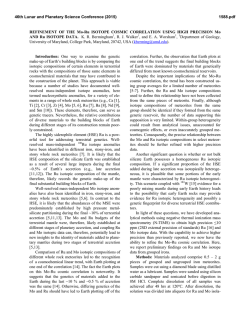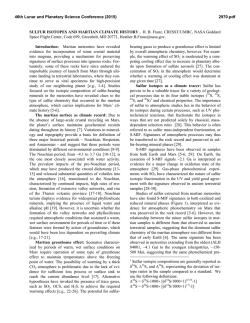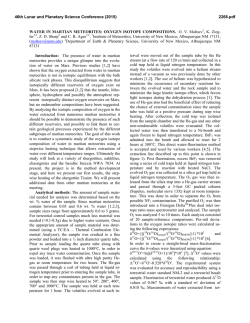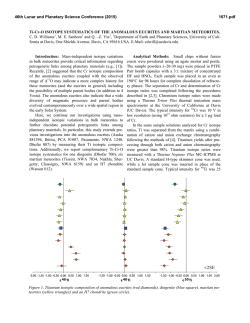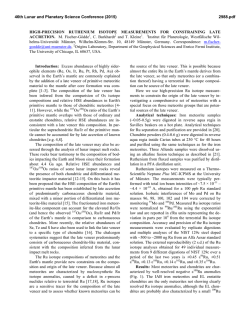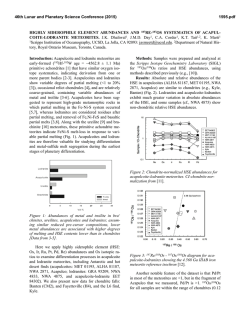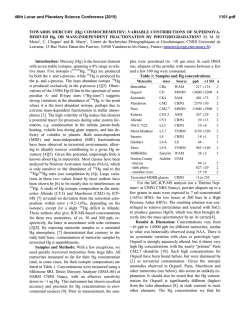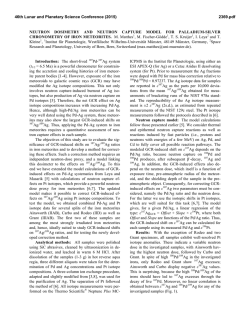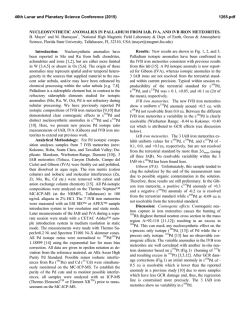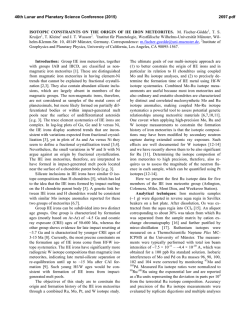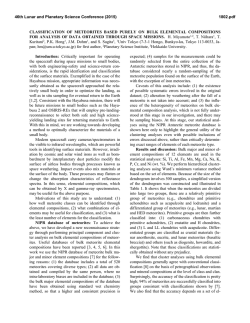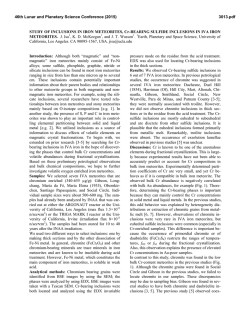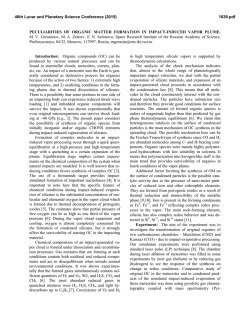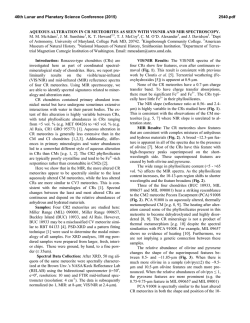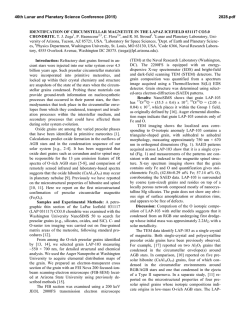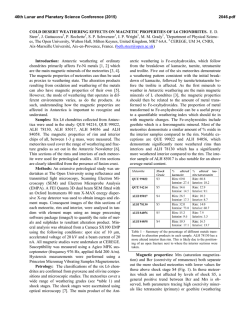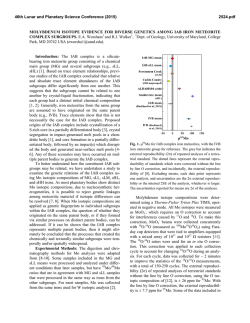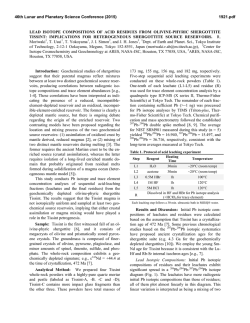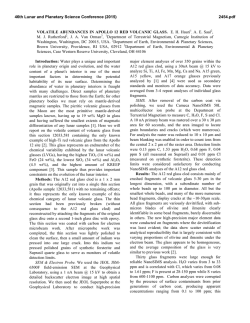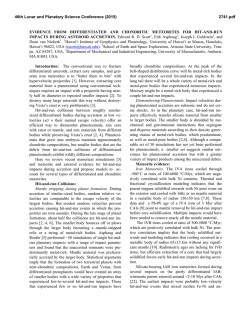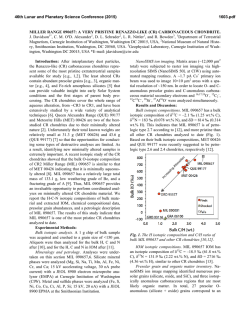
2597
46th Lunar and Planetary Science Conference (2015) 2597.pdf SULFUR ISOTOPES OF MAIN GROUP PALLASITES SUPPORT LINKS TO IIIAB IRON METEORITES. J. W. Dottin III1, J. Farquhar1, J. Labidi2,1Department of Geology, University of Maryland, College Park MD 20742, 2Carnegie Institute of Washington. Introduction: Sulfur isotopes have been studied in a variety of meteorites including chondrites, iron meteorites, HEDs, acapulcoite-lodranites, and ureilites [18]. These studies have revealed isotopic anomalies that have been attributed to both photochemical and nucleosynthetic processes. This study presents sulfur isotope data on 9 pallasites from four different subgroups as characterized by [9] with the aim of determining whether sulfur anomaly(s) are present, and if so understanding their significance. Pallasites are stony-iron meteorites containing subequal amounts of olivine and metal [10]. They are believed to have formed via rapid intrusion of massive amounts of metal into an olivine cumulate. Ni, Ge, Ga, Fe, and Au isotopes and concentrations provide evidence for a relationship between IIIAB iron meteorites and pallasites [3-5]. Such a relationship would imply that the IIIAB iron meteorites could be a sample of an unmixed metal pool adjacent to the pallasite location [10]. Such a hypothesis might be testable with sulfur isotopes. Antonelli and others [5] recently documented sulfur isotope heterogeneity between some groups of iron meteorites that can be used for comparison between pallasites and members of the IIIAB iron meteorites in order to better constrain the possibility that the two have a genetic relationship on a single parent body [10]. Methods: Acid volatile sulfur was extracted from crushed troilite nodules extracted from various pallasites. Samples were placed in round bottom boiling flasks and heated in a pool of 5N HCl. The 5N HCl was bubbled using N2 gas. From this heating and bubbling technique, H2S gas was released and traveled through the condensers where it was eventually captured in a slightly acidic capturing solution (AgNO3). From this capturing solution, Ag2S was precipitated. The Ag2S was rinsed with Milli-Q water and soaked in 1 M NH4OH before drying. The Ag2S was then reacted with pure excess F2 in nickel tubes overnight, ultimately producing SF6 gas. The SF6 was then purified via cryogenic and gas chromatographic techniques. Lastly, the SF6 gas was analyzed using dual inlet Isotope Ratio Mass Spectrometry (IRMS) at the University of Maryland. The data are presented in per mil using δ34S, Δ33S, and Δ36S and normalized directly to the Canyon Diablo Troilite (CDT) sulfur standard. The 2σ uncertainties for δ34S, Δ33S, and Δ36S are estimated on the basis of long-term reproducibility of samples analyzed by the same procedures [5] to be ± 0.2 ‰, ±0.004 ‰, and ± 0.2 ‰, respectively. Results: Table 1 reports data for the 7 Pallasites analyzed in this study. The results are also shown in figure 1 and figure 2 as δ34S versus Δ33S and Δ33S versus Δ36S respectively. For all pallasite samples presented we observe δ34S values that range from -0.23 to 0.36 ‰, Δ33S ranges from -0.02 to 0.022 ‰, and Δ36S ranges from -0.045 to 0.005 ‰. Table 1. Sulfur isotopic data for Pallasite samples Group Pallasite Sample δ34S Δ33S ……..... Δ36S Main Group Very High Nickel Giroux -0.23 0.017 -0.038 Brahin -0.018 0.016 -0.031 Main group Moderate Nickel Thiel Mts. -0.09 0.014 -0.029 Main Group Low Nickel Marjalahti 0.069 -0.018 0.005 Imilac 0.11 0.020 -0.035 Main Group Anomalous Silicate Brenham 0.36 0.017 -0.024 Main Group Anomalous Metal Glorieta Mt. -0.20 0.022 -0.045 46th Lunar and Planetary Science Conference (2015) Figure 1. δ34S versus Δ33S for pallasite samples Error in this figure has been determined to be ± 0.2 ‰, ±0.004 ‰ and ± 0.2 ‰ for δ34S, Δ33S, and Δ36S respectively based on long term reproducibility of samples analyzed using the same procedures. Figure 2. Δ33S versus Δ36S for pallasite samples Error in this figure has been determined to be ± 0.2 ‰, ±0.004 ‰ and ± 0.2 ‰ for δ34S, Δ33S, and Δ36S respectively based on long term reproducibility of samples analyzed using the same procedures. Discussion: The isotopic data define a group of data points for Brenham, Glorieta Mt., Giroux, Imilac, Brahin, and Thiel Mts. that form a cluster with overlapping uncertainties. One data point for Marjalahti falls outside of this cluster. The data presented above falls within the range of isotope values measured previously for chondrites, iron meteorites, HED meteorites, urelites, and acapulcoite-lodranites [1-8]. They all reveal small enrichments in Δ33S values. The IIIAB iron meteorites analyzed by [5] yield similar sulfur isotopic compositions to those seen for the cluster of data that are permissive of the suggested 2597.pdf relationship between these two meteorite groups [10]. The IIIAB iron meteorites yield: a δ34S(‰ ± 2 S.E.) of 0.12±0.32 compared to 0.00±0.17; a Δ33S of 0.018±0.004 compared to 0.018±0.002; and a Δ36S of -0.05±0.09 compared to -0.03±0.01. The different sulfur isotopic composition of Marjalahti may be significant, but given that it is a single analysis, we are hesitant to rule out the possibility that it is in error. Further work is planned to evaluate this possibility and to evaluate whether there may be differences in the sulfur isotopic composition that can be related to the specific group each pallasite meteorite belongs to. Presently however, we do not see any special patterns or groupings related to Δ33S that suggests differences in isotope fractionation on different parent bodies. We are now in the process of continuing this investigation by repeating analyses and measuring more pallasites with the intent on having a full representative suite. With further investigation, we will be able to better constrain the origin of the small fractionations in sulfur and also determine possible origins on different parent bodies that experienced differences in their sulfur fractionation. References: [1] Farquhar J. et al. (2000) GCA, 64, 1819-1825. [2] Gao X. and Thiemens M.H. (1991) GCA, 55, 2671-2679. [3] Rai V.K. and Thiemens M.H. (2007) GCA, 71, 1341-1354. [4] Lovering J.F. (1957) GCA, 11, 263-278. [5] Antonelli M.A. (2014) PNAS, 50, 17749-17754. [6] Gao X. and Thiemens M.H. (1993) GCA, 71, 3159-3169. [7] Gao X. and Thiemens M.H. (1993) GCA, 57, 3171-3176. [8] Bullock E.S. et al. MPS, 45, 885-898. [9] Wasson and Choi (2003) GCA, 67, 3079-3096. [10] Scott E.R.D. (1977) GCA, 41, 349-360.
© Copyright 2025
